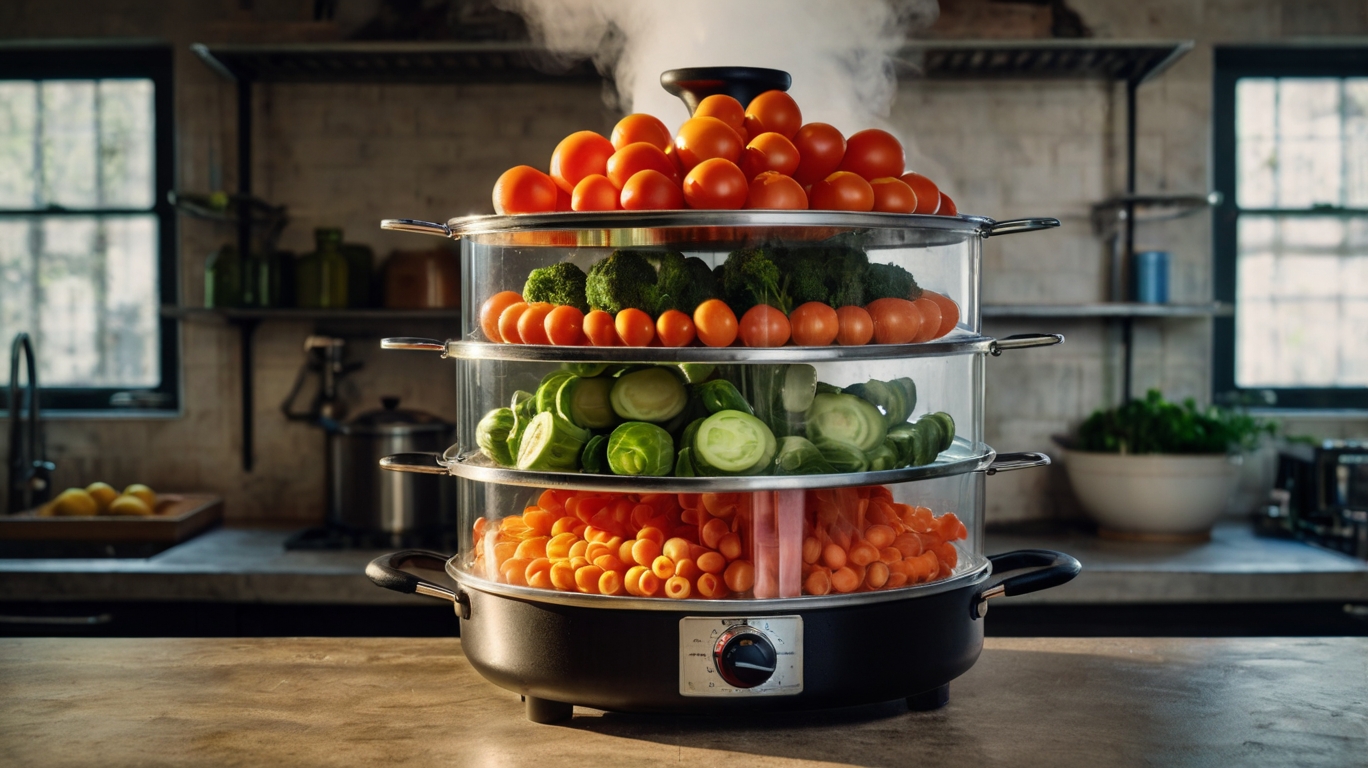 Mind
Mind
- Digital and Modern Well-being
- Mental Health and Emotional Well-being
- Mind-Body Connection and Holistic Health
- Parenting and Family
- Personal Growth and Development
- Relationships and Social Well-being
- Stress and Relaxation
- Therapeutic and Creative Practices
- Trauma and Recovery
- Work, Productivity, and Discipline
 Body
Body
 Fitness
Fitness
 Food
Food
 Beauty
Beauty
How to Steam Vegetables for Maximum Nutrient Retention

Steaming vegetables is one of the healthiest cooking methods, allowing you to preserve not only the vibrant colours and fresh flavours but also the essential nutrients. Unlike boiling, which can cause vitamins and minerals to leach into the water, steaming locks in the goodness while giving your vegetables a tender, crisp texture. For anyone focused on health and wellbeing, understanding how to steam vegetables properly can make a big difference in the nutritional value of your meals.
In this guide, we’ll cover everything you need to know about steaming vegetables, from its health benefits to step-by-step instructions and tips for the best results.
The Benefits of Steaming Vegetables
Before diving into the how-to, it’s important to understand why steaming is such an excellent method for cooking vegetables.
Nutrient Retention: Steaming is gentle on vegetables, allowing them to retain more vitamins, especially water-soluble ones like vitamin C and many B vitamins. Studies show that steaming can preserve more nutrients compared to other methods such as boiling or frying.
Low in Fat: Steaming requires no oils or fats, making it a great option for those looking to maintain or reduce their fat intake while still enjoying flavourful, nutritious meals.
Enhanced Flavour: Steaming brings out the natural flavours of vegetables, allowing you to enjoy them in their purest form without the need for added salt or seasoning.
Preservation of Texture and Colour: Steamed vegetables retain their vibrant colours and crisp texture, adding visual appeal to your meals while providing the satisfying crunch of freshness.
Now that we understand why steaming is so beneficial, let’s look at how to do it properly.
Step-by-Step Guide to Steaming Vegetables
Here’s a simple yet detailed process for steaming vegetables that will ensure maximum nutrient retention and flavour.
1. Choose Fresh, High-Quality Vegetables
The first step to any healthy dish is starting with fresh, high-quality ingredients. Whether you’re steaming broccoli, carrots, spinach, or any other vegetables, look for ones that are firm, brightly coloured, and free of blemishes or wilted spots.
2. Prep Your Vegetables
Wash your vegetables thoroughly to remove any dirt or pesticides. Depending on the type of vegetable, you may need to peel or trim them. For example:
- Broccoli: Cut into small, evenly sized florets to ensure they steam uniformly.
- Carrots: Peel and slice them into thin rounds or sticks for quicker steaming.
- Spinach: Rinse the leaves well, and remove any thick stems.
- Cauliflower: Like broccoli, cut into bite-sized florets.
The key to even steaming is cutting vegetables into uniform pieces so they all cook at the same rate.
3. Set Up Your Steamer
You can steam vegetables using various tools:
Steamer Basket: This is the most common method. Place the basket in a pot with about an inch or two of water at the bottom. Ensure the water does not touch the vegetables.
Electric Steamer: These handy appliances allow you to stack different trays of vegetables, and they steam them with precise timing.
Microwave Steaming: You can also steam vegetables in the microwave. Place them in a microwave-safe bowl with a small amount of water, cover with a lid or cling film (leaving a small vent), and steam on high heat.
No matter which method you choose, ensure that the vegetables are elevated above the water, as you want them to cook with steam, not by boiling.
4. Steam with Precision
Here’s a guideline for how long to steam various vegetables:
- Broccoli and Cauliflower: 4-6 minutes
- Carrots: 5-7 minutes (depending on thickness)
- Spinach or Kale: 2-3 minutes
- Green Beans: 5-6 minutes
- Asparagus: 4-5 minutes
- Peas: 3-4 minutes
The aim is to steam them until they are tender yet still bright in colour. Overcooking can cause vegetables to become mushy and lose their vibrant appearance and nutritional value.
5. Check for Doneness
To check whether your vegetables are done, use a fork or knife to test the firmness. The vegetables should be soft enough to pierce but still slightly firm for a bit of crunch. They shouldn’t feel too soft or fall apart when you poke them.
6. Enhancing Flavour (Without Compromising Health)
While steamed vegetables are delicious on their own, a few simple enhancements can make them even more flavourful:
Herbs and Spices: Fresh herbs like parsley, dill, or thyme add a fresh and vibrant touch. A sprinkle of black pepper or paprika can add warmth without overpowering the natural flavours.
Citrus: A squeeze of lemon or lime over steamed vegetables can brighten the dish, giving it a zesty freshness without adding sodium or fat.
Garlic and Ginger: Finely grated garlic or ginger can elevate the flavour of steamed vegetables, especially in dishes with an Asian or Mediterranean flair.
Olive Oil Drizzle: If you’re not avoiding fats entirely, a small drizzle of high-quality extra virgin olive oil can add richness and improve the absorption of fat-soluble vitamins like A, D, E, and K found in many vegetables.
7. Avoiding Common Mistakes
To get the most out of steaming, avoid these common mistakes:
Overcrowding the Steamer: Vegetables need space for the steam to circulate. Overcrowding the basket can result in uneven cooking. Steam in batches if necessary.
Using Too Much Water: The water should not touch the vegetables, as this will cause them to boil rather than steam, potentially reducing their nutrient content.
Steaming Too Long: Oversteaming can lead to mushy vegetables that have lost much of their flavour and nutrients. Keep a close eye on the time, and remember that vegetables will continue to soften slightly after you remove them from the heat.
Nutrient Retention and Health Benefits
Steaming helps preserve many of the key nutrients in vegetables, such as:
Vitamin C: This is a heat-sensitive vitamin that is often lost in cooking. Steaming reduces the amount of contact with water, helping vegetables like broccoli and bell peppers retain more of their vitamin C content.
B Vitamins: These are also water-soluble, meaning they can be lost during boiling. Steaming vegetables like spinach and peas helps keep these essential nutrients intact.
Antioxidants: Many vegetables are rich in antioxidants, which can degrade with prolonged exposure to heat. Steaming protects these compounds better than frying or boiling.
In addition to nutrient retention, steaming can also enhance the bioavailability of certain nutrients. For example, steaming carrots increases their beta-carotene content, making it easier for your body to absorb this beneficial antioxidant.
Best Vegetables to Steam
While you can steam almost any vegetable, some are particularly well-suited to this method:
Broccoli: Steaming broccoli keeps it crunchy and retains its high levels of vitamin C, fibre, and antioxidants.
Spinach: This leafy green wilts quickly when steamed but maintains its rich iron and folate content.
Carrots: Steaming brings out the natural sweetness of carrots while preserving their beta-carotene.
Cauliflower: Another cruciferous vegetable that retains both its texture and nutrition when steamed.
Final Thoughts
Steaming vegetables is a simple yet powerful way to cook healthily while maximising nutrient retention. Whether you’re preparing a side dish or the base for a hearty main course, steaming allows you to enjoy the natural goodness of vegetables without added fats or sodium. With the right technique, steamed vegetables can be crisp, colourful, and packed with flavour—offering both taste and health benefits in every bite.
Give it a try, and see how this cooking method can transform your meals!
